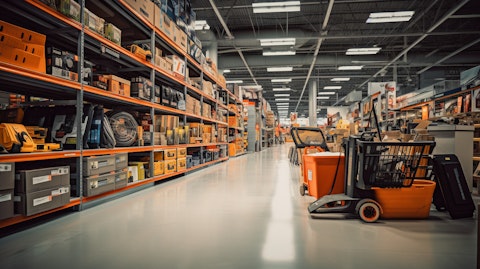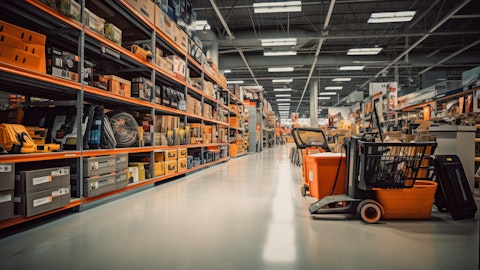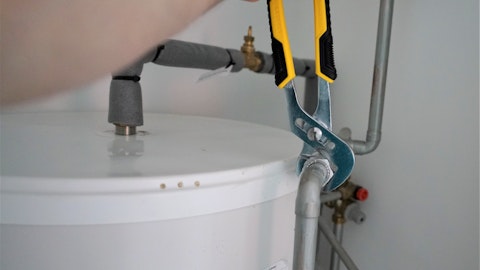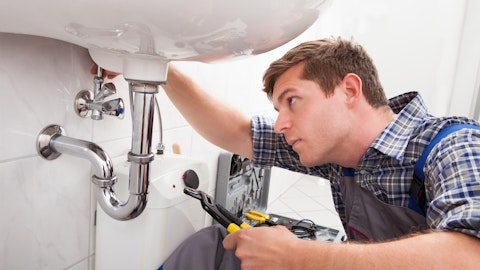Masco Corporation (NYSE:MAS) Q1 2024 Earnings Call Transcript April 24, 2024
Masco Corporation beats earnings expectations. Reported EPS is $0.93, expectations were $0.87. MAS isn’t one of the 30 most popular stocks among hedge funds at the end of the third quarter (see the details here).
Operator: Good morning ladies and gentlemen. Welcome to Masco Corporation’s First Quarter 2024 Conference Call. My name is Ludie and I will be your operator for today’s call. As a reminder, today’s conference is being recorded for replay purposes. [Operator Instructions] I will now turn the call over to Robin Zondervan. You may begin.
Robin Zondervan: Thank you, operator and good morning everyone. Welcome to Masco Corporation’s 2024 first quarter conference call. With me today are Keith Allman, President and CEO of Masco; and Rick Westenberg, Masco’s Vice President and Chief Financial Officer. Our first quarter earnings release and the presentation slides are available on our website under Investor Relations. Following our remarks, we will open the call for analyst questions. Please limit yourself to one question with one follow-up. If we can’t take your question now, please call me directly at 313-792-5500. Our statements today will include our views about our future performance, which constitute forward-looking statements. These statements are subject to risks and uncertainties that could cause our actual results to differ materially from the forward-looking statements.
We’ve described these risks and uncertainties in our risk factors and other disclosures in our Form 10-K and our Form 10-Q that we filed with the Securities and Exchange Commission. Our statements also include non-GAAP financial metrics. Our references to operating profit and earnings per share will be as-adjusted unless otherwise noted. We reconcile these adjusted metrics to GAAP in our earnings release and presentation slides, which are available on our website under Investor Relations. With that, I will now turn the call over to Keith.
Keith Allman: Thank you, Robin. Good morning everyone and thank you for joining us today. Please turn to Slide 5. I’m very pleased with our strong start to the year as we reported another quarter of operating profit margin expansion and EPS growth compared to the prior year. Our results were driven by improved operational efficiencies, solid execution, and the strength of our repair and remodel product portfolio. We remain focused on growing our market share by engaging with our customers, launching innovative new products, and building on the value of our brands. Turning to our overall company performance. Our top line decreased 3% in the quarter, which was in line with our expectations. Volume was down 4%, partially offset by pricing actions of 1% and the impact of our recent acquisition of Sauna360, which we finalized in the third quarter of the prior year.
Operating profit improved in the quarter by $10 million to $322 million [indiscernible], and operating margin grew 90 basis points to 16.7%. The improvement in our operational performance was primarily driven by cost savings initiatives and a favorable price/cost relationship, partially offset by lower volume. Our earnings per share grew 8% to $0.93 per share. Turning to our segments. Plumbing sales declined 2% overall and 4% excluding acquisitions. In local currency, North American Plumbing sales decreased 1%, including the favorable impact of acquisitions. In International Plumbing, sales decreased 5%. Operating profit for the segment was up $26 million to $228 million, and operating margin was up 260 basis points to 19.1%. In addition to our focus on operational excellence and continuous improvement, both our North American and International Plumbing businesses remain focused on developing new and innovative products that serve the needs of our customers.
In North American Plumbing, for example, Delta Faucet showcased several new and award-winning products at the Kitchen and Bath Industry Show held in February, including a multilevel offering of steam showers, headlined by the Brizo Mystix steam shower system, a tankless reverse osmosis water filtration system and several cross expansions in brick-and-mortar retail and in the bathing category online, all of which are launching later this year. In our spa business, Watkins Wellness launched FreshWater IQ, a smart monitoring system that automatically test the water in your spa and communicates recommendations when adjustments are needed to maintain clean natural feeling water. This breakthrough technology provides our customers with a superior ownership experience and continues the legacy of innovation that makes Watkins Wellness, an industry leader in the spa market.
In our International Plumbing business, Hansgrohe AXOR brand recently presented a variety of new products at the Milan Furniture Fair, including the Citterio C bathroom collection, customization options with AXOR signature service and the AXOR ShowerSelect ID temperature control technology. These products continue to demonstrate Hansgrohe’s innovative bathroom solutions, which offer premium design, while simultaneously saving energy and water. With our strong brands, global presence and innovative products, our Plumbing segment is well positioned to continue to gain global market share. Turning next to our Decorative Architectural segment. Sales declined 3%. PRO paint and DIY paint sales were both relatively flat year-over-year. Operating profit for the segment declined by $8 million to $125 million, and operating margin declined 60 basis points to 17%.
In our paint business, we remain focused on working closely with our partner, the Home Depot to drive further share gains with both PRO and DIY paint customers. During the quarter, Behr continued to invest in services focused on meeting the needs of the PRO painter. This included expanding the PRO sales force into additional markets across the United States, increasing job site delivery availability and providing exceptional brand loyalty programs. Additionally, in a recent third-party quality study, Behr was rated number one in interior paint, number one in exterior paint and number one in exterior stain demonstrating the strength and exceptional quality of our leading Behr brand. Moving to capital allocation. Our strategy remains unchanged.

During the quarter, we returned $212 million to shareholders through the repurchase of 2.1 million shares for $148 million and a dividend payment of $64 million. Now, turning to our outlook for the remainder of 2024. With the year beginning largely as expected, we continue to anticipate that 2024 adjusted earnings per share will be in the range of $4 to $4.25 per share. While we expect a relatively flat top line for the year, our focus on cost savings initiatives, disciplined pricing, and operational efficiencies will help us continue to drive operating margin improvement and earnings per share growth in 2024. For the remainder of the year, we remain cautiously optimistic as we continue to monitor inflation data, the likelihood of current year interest rate cuts and changes in consumer confidence levels.
However, we continue to believe the fundamentals of our repair and remodel markets are strong and that structural factors, such as the age of housing stock, consumers staying in their homes longer and higher home equity levels will drive increased repair and remodel activity over the mid to long term. We believe these favorable fundamentals, our portfolio of low-ticket repair and remodel products. Our focus on operational excellence and our disciplined capital allocation strategy will continue to drive shareholder value creation. Now, I will turn the call over to Rick to go through our first quarter results and the 2024 outlook in more detail. Rick?
Rick Westenberg: Thank you, Keith, and good morning, everyone. Thank you for joining. As Robin mentioned, my comments today will focus on adjusted performance, excluding the impact of rationalization charges and other onetime items. Turning to slide 7. Sales in the quarter decreased 3% year-over-year or decreased 4%, excluding the favorable impact of our Sauna360 acquisition in the third quarter of last year. FX has a minimal impact on our first quarter results. In local currency, North American sales decreased 2% or 3% excluding acquisitions. In local currency, international sales decreased 5%. Despite lower sales, our continued efforts to drive operational efficiencies as well as our price cost performance in the quarter, helped lead to gross margin expansion of 210 basis points to 35.7%.
SG&A as a percent of sales was 19.1% and was impacted by high employee-related costs including incentive compensation. Overall, our operating profit grew 3% in the quarter, and margin expanded 90 basis points to 16.7%. This strong operating profit and margin performance was due primarily to cost savings initiatives and a favorable price cost relationship, partially offset by lower volumes. We also grew EPS during the quarter by 8% to $0.93 per share. Turning to slide 8. Plumbing sales decreased 2% in the quarter, in line with our expectations. Lower volume and mix reduced sales by 7%. This was partially offset by favorable pricing of 3% and the positive impact of acquisitions of 2%. North American Plumbing sales decreased 1%, however, decreased 4% excluding acquisitions.
Delta Faucet had another solid quarter, achieving low single-digit revenue growth, driven by continued strength in the wholesale channel. In local currency, International Plumbing sales decreased 5%, driven by soft demand in our key markets of Europe and China. Segment operating profit in the first quarter was up $26 million or 13% year-over-year and operating margin expanded 260 basis points to 19.1%. This operating profit improvement was driven by cost savings initiatives and a favorable price/cost relationship, partially offset by lower volume and mix. Turning to Slide 9. Decorative Architectural sales decreased 3% for the first quarter. Paint sales were relatively flat year-over-year with sales in both DIY and PRO paint in line with last year.
This performance was consistent with our expectations, and we continue to anticipate our full year DIY paint business to decrease low single-digits and our PRO paint business to increase low single-digits. Operating profit was $125 million and operating margin was 17%, down 60 basis points year-over-year, primarily due to lower pricing, partially offset by cost savings initiatives. Turning to Slide 10. Our balance sheet remains strong with gross debt-to-EBITDA at two times at quarter end. We ended the quarter with $1.3 billion of liquidity, including cash and availability under our revolving credit facility. Working capital as a percentage of sales declined 50 basis points to 18.6% as we continue to stay disciplined on our working capital levels.
During the first quarter, we repurchased 2.1 million shares for $148 million and paid a dividend of $64 million to shareholders. As we discussed on our February earnings call, we continue to anticipate deploying approximately $600 million during the year towards share repurchases or acquisitions. Now, let’s turn to Slide 11 and review our outlook for 2024. The year has started largely as expected and as a result, we are maintaining our full year outlook, which is as follows. For Masco overall, we expect 2024 sales to be roughly flat with operating margin growing to approximately 17%. Currency is projected to have minimal impact on our results. We expect sales to be down slightly in the first half of the year with modest growth in the back half of the year.
Additionally, we expect operating margin to be roughly flat in the first half of the year, with expansion expected in the second half. In our Plumbing segment, we expect 2024 full year sales to be plus or minus low single-digits versus 2023 and our operating margin to expand to approximately 18.5% up from our prior year margin of 18%. Margin expansion will be primarily driven by pricing discipline, operational efficiency and continued cost savings initiatives. In our Decorative Architectural segment, we expect 2024 sales to also be plus or minus low single-digit versus 2023 and operating margin to be approximately 18%, up from our prior year margin of 17.8%, driven by cost savings initiatives. Finally, as Keith mentioned earlier, we are maintaining our 2024 EPS estimate of $4 to $4.25 per share.
This assumes a $221 million average diluted share count for the year and a 24.5% effective tax rate. Additional financial assumptions for 2024 can be found on Slide 14 of our earnings deck. With that, I’d like to open up the call for questions. Operator?
See also 10 Micro-Cap Healthcare Stocks Insiders Are Buying and 10 Buy-Rated Stocks with Latest Insider Purchases.
Q&A Session
Follow Masco Corp (NYSE:MAS)
Follow Masco Corp (NYSE:MAS)
Operator: Thank you. We will now begin the question-and-answer session. [Operator Instructions] Your first question comes from the line of Anthony Pettinari from Citi. Your line is open.
Anthony Pettinari: Good morning. DIY paint accelerated pretty meaningfully from 4Q to 1Q. And I’m just wondering if you could talk a little bit about whether that acceleration was related more towards improving demand or maybe the timing of comps? And how should we think about maybe pathway to restoring price/cost and DA given volumes are improving?
Keith Allman: I’m not quite tracking with you, Anthony, in terms of volumes improving. Tell me what you mean by that?
Anthony Pettinari: I guess, the move from DIY paint from 4Q to 1Q, if you could just talk about the trends you’re seeing there.
Keith Allman: Well, I’d tell you that we’ve — when we look at the rate of volume decline that we’re seeing across our business and specifically in DIY paint. We continue to see that the market is down a little bit. We haven’t really seen a restoration of volumes. I don’t know if you’re implying sequentially or if you’re looking at year-over-year.
Anthony Pettinari: Yes, year-over-year.
Rick Westenberg: Yes, Anthony, the only thing I would add is there’s nothing really noteworthy in terms of trends. I think it’s more seasonality. But in terms of our DIY performance as well as our PRO volume or sales performance, it was roughly flat year-over-year on a Q1-to-Q1 basis. And as we indicated in terms of the calendar year outlook, which is probably more meaningful on a calendar basis, we do expect DIY to be down low single digits, but PRO to be up low single digits. So that provides some context in terms of what we’re expecting this year.
Anthony Pettinari: Okay. That’s very helpful. And then I’m just plumbing ball mix, I think, decelerated from down 4% in 4Q to down 7% in 1Q despite what looked like an easier comp. I’m just wondering if you could talk about if that — if you view that as a deceleration, if there’s anything in the weaker channels that you’d flag and maybe just more broadly about trends that you’re seeing in Kitchen and Bath remodel that you’d identify as maybe tracking better or worse than expected for Masco?
Rick Westenberg: Yes. I think in terms of what we’re seeing on a sequential basis on a year-over-year, but a sequential basis, as you articulated, I think that’s driven largely by the geographic performance. So — it wasn’t really until Q2 of last year where we saw more of a slowdown in our international market. And so as we look on a year-over-year basis, our North America Plumbing was down 1% or 2%. But our International Plumbing was down about 5% on a currency-adjusted basis. So, I think that’s perhaps explaining the dynamics that you’re seeing. I guess, I’ll let maybe Keith comment in terms of the trends as we see going forward in terms of the Plumbing business in Kitchen and Bath?
Keith Allman: Yeah. When we look at our rate of decline in Plumbing. It really shows a moderation in terms of what I would call stabilization, probably a better word, particularly in North America. The slowdown last year happened, as Rick said, a couple of quarters later in our International business. So our — in North America, our trade business is doing quite well. And overall in North America is stable. We feel it’s safe to say that we’ve hit the bottom in North America, a little bit different story internationally. More stability in Germany, certainly, but there’s still some variability in China. So it’s maybe a little bit too early to call to say that we’ve seeing that hit bottom in North America. So we’re expecting our international sales to be down a little bit more in terms of the total market this year than we would in North America.
Anthony Pettinari: Okay. That’s very helpful. I’ll turn it over.
Operator: Thank you. Your next question comes from the line of John Lovallo from UBS. Your line is open.
John Lovallo: Good morning, guys. Thank you for taking my questions here as well. Maybe starting at a high level, just talking or thinking about your outlook for repair and remodel sort of flat to down low single digits. But we’ve had a move in rates here and perhaps a little bit more pressure on existing home sales. Just curious if you’re kind of leaning more towards upside or downside there, if anything has changed in your overall thought process?
Keith Allman: Good morning, John. Really no change. We’ve performed this quarter as expected. We’re holding our guidance and believe that we will start to see an uptick in the second half in the overall market. But — no real changes as we see it in terms of how the consumer is behaving. Certainly, there’s volatility left and that we’re calling for flat, plus or minus low single digits. And our market is driven primarily by consumer confidence. So we’re watching carefully where the rates go, what happens geopolitically. There’s a lot of dynamics here, but fundamentally, how we view the market has not changed. And by and large, first quarter came in right where we expected it to come in.
John Lovallo: Okay. Yeah, that’s encouraging. And then considering that DIY and PRO paint were both sort of flattish on a sales basis year-over-year. That would seem to imply that Kichler and the hardware business were down maybe closer to 15%. I mean are we thinking about that right? What’s — and if so, what’s sort of driving that? And then how are you thinking about these businesses as we move through the year?
Rick Westenberg: Yeah. No, I follow your math, John. It wasn’t quite that significant, but Kichler and Liberty were down a bit more than our overall portfolio. And some of that’s driven based off of decisions that are made. For example, Kichler has done a really nice job at taking some restructuring actions with regards to cost and price, but also portfolio exiting some lines of business that weren’t as profitable. So that’s driving a little bit of the year-over-year comp. And as we look for the rest of the year, I think what we will expect to see in terms of those business lines is more in line with the R&R industry as we kind of lap some of the comps.
John Lovallo: Great. Thank you, guys.
Operator: Your next question comes from the line of Matthew Bouley from Barclays. Your line is open.



